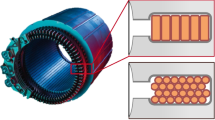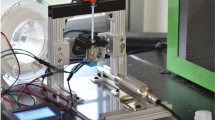Abstract
A combined cold extrusion process is experimentally visualized to manufacture a drive shaft. Due to the requirements of a face width of about 92.00 mm for the spur gear section and a groove depth of roughly 22.70 mm for the internal spline region, a preform is adopted to prevent excessive accumulation of plastic deformation. AISI 1035 medium carbon steel material is spheroidized and annealed to use as the initial billet workpiece. In order to verify the deformed configuration and the dimensional accuracy, both shoulder angles of (θ1, θ2) are selected to be (30°, 30°) and (45°, 45°) on each extrusion die for the preform forging and the combined extrusion. Using the prepared tool components, experimental investigations on the dimensional relevancy of the cold forged drive shaft are performed. When the shoulder angle set of (30°, 30°) is applied, the required dimensions with respect to the face width and the groove depth are sufficiently satisfied, but unpredictable forging defects are observed. With the shoulder angles of (45°, 45°), the drive shaft is well deformed and fabricated without any cold forging defects. As a result, it is confirmed that the drive shaft can successfully be actualized with the dimensional precision satisfied by the combined cold extrusion.
Similar content being viewed by others
References
T. W. Ku, A study on two-stage cold forging for a drive shaft with internal spline and spur gear geometries, Metals, 8(11), (2018) 953.
T. W. Ku, A combined cold extrusion for a drive shaft: a parametric study on tool geometry, Materials, 13(10), (2020) 2244.
J. H. Song and Y. T. Im, The applicability of process design system for forward extrusion of spur gears, Journal of Materials Processing Technology, 184(1–3), (2007) 411–419.
T. Maeno, K. Mori, Y. Ichikawa and M. Sugawara, Use of liquid lubricant for backward extrusion of cup with internal spline using pulsating motion, Journal of Materials Processing Technology, 244, (2017) 273–283.
T. W. Ku and B. S. Kang, Tool design for inner race cold forging with skew-type cross ball grooves, Journal of Materials Processing Technology, 214(8), (2014) 1482–1502.
S. Brunbauer, G. Winter, T. Antretter, P. Staron and W. Ecker, Residual stress and microstructure evolution in steel tubes for different cooling conditions — simulation and verification, Materials Science and Engineering: A, 747, (2019) 73–79.
M. Sedighi and S. Tokmechi, A new approach to preform design in forging process of complex parts, Journal of Materials Processing Technology, 197(1–3), (2008) 314–324.
T. W. Ku, L. H. Lee and B. S. Kang, Multi-stage cold forging and experimental investigation for the outer race of constant velocity joints, Materials and Design, 49, (2013) 368–385.
M. S. Joun, J. H. Chung and R. Shivpuri, An axisymmetric forging approach to preform design in ring rolling using a rigid-viscoplastic finite element method, International Journal of Machine Tools and Manufacture, 38(10–11), (1998) 1183–1191.
J. M. O’Brien and W. F. Hosford, Spheroidization cycles for medium carbon steels, Metallurgical and Materials Transactions A, 33(4), (2002) 1255–1261.
T. W. Ku and B. S. Kang, Tool design and experimental verification for multi-stage cold forging process of the outer race, International Journal of Precision Engineering and Manufacturing, 15(9), (2014) 1995–2004.
T. W. Ku and B. S. Kang, Hardness-controlled tool fabrication and application to cold forging of inner race with skewed ball grooves, The International Journal of Advanced Manufacturing Technology, 74(9–12), (2014) 1337–1354.
Acknowledgments
This work was supported by the Engineering Research Center Program (NRF-2019R1A5A6099595) and the Basic Science Research Program (NRF-2017R1D1A1B03032741) through the National Research Foundation of Korea (NRF) grant funded by the Korea government.
Author information
Authors and Affiliations
Corresponding author
Additional information
Tae-Wan Ku is a Professor of the Engineering Research Center of Innovative Technology on Advanced Forming, and Department of Green Transportation System Design at Pusan National University, Busan, Republic of Korea. He received his Ph.D. in Aerospace Engineering from Pusan National University. His research interests include multi-stage metal forming, smart forming process, process design and simplification, and applications to the manufacturing fields.
Rights and permissions
About this article
Cite this article
Ku, TW. A combined cold extrusion for a drive shaft: experimental assessment on dimensional compatibility. J Mech Sci Technol 34, 5213–5222 (2020). https://doi.org/10.1007/s12206-020-1123-2
Received:
Revised:
Accepted:
Published:
Issue Date:
DOI: https://doi.org/10.1007/s12206-020-1123-2




